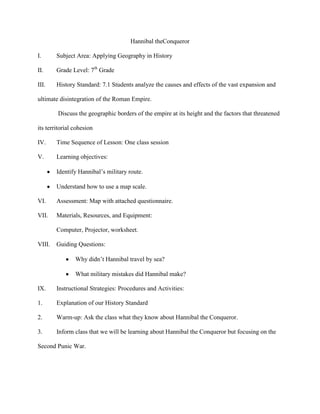
Last blog
- 1. Hannibal theConqueror I. Subject Area: Applying Geography in History II. Grade Level: 7th Grade III. History Standard: 7.1 Students analyze the causes and effects of the vast expansion and ultimate disintegration of the Roman Empire. Discuss the geographic borders of the empire at its height and the factors that threatened its territorial cohesion IV. Time Sequence of Lesson: One class session V. Learning objectives: Identify Hannibal’s military route. Understand how to use a map scale. VI. Assessment: Map with attached questionnaire. VII. Materials, Resources, and Equipment: Computer, Projector, worksheet. VIII. Guiding Questions: Why didn’t Hannibal travel by sea? What military mistakes did Hannibal make? IX. Instructional Strategies: Procedures and Activities: 1. Explanation of our History Standard 2. Warm-up: Ask the class what they know about Hannibal the Conqueror. 3. Inform class that we will be learning about Hannibal the Conqueror but focusing on the Second Punic War.
- 2. 4. Explain the Second Punic War:lasted from 218 to 201BC, between the Romans and Carthage and the Roman Republic. They are called the “Punic Wars” because Rome’s name for the Carthaginians was Punici, a reference to their Phoenician ancestry. -War began by Hannibal's surprising overland journey and his costly crossing of the Alps, followed by his reinforcement by Gaulish allies and crushing victories over Roman armies in the battle of the Trebia and the giant ambush at Trasimene. Hannibal used the Appian Way (Via Appia) to travel through Rome. 5. Visit website, http://www.historyworld.net/wrldhis/plaintexthistories.asp?historyid=ac53 for Second Punic War timeline. Compare the timeline with the map provided. 6. Present Map: Explain Hannibal’s route.
- 3. 7. Google Earth Map of Southern Italy. Shows many of the Greek cities fought over by Hannibal and the Romans. The original Appian Way is in white; the alternative road (in pink) was constructed 400 years later under Emperor Trajan. 8. Handout: Handout a map and have students plot a different military route. Have them plan their own military campaign to conquer the Roman Territory X. Closing/Reflection: What countries did Hannibal invade and conquer? How years did the Second Punic Wars occur?
- 4. Lesson Plan by: Nathalie, Sarah, and Jordan. In this lesson plan, students will understand the History standards that are being presented. They will be able to learn the following objectives: Identify Hannibal’s military route and understand how to use a map scale Geography is being incorporated in this lesson plan by examining Hannibal military route to conquer the Roman territory. Since we are focusing on the Second Punic War, students will have a better understanding of the war and Europe by seeing an enlarged map. By locating other countries in Europe, students will also learnWorld Geography and how to use a map scale.